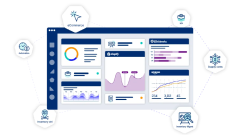Expert financial reminders to help make 2025 your most profitable year

A blog from our partners at LedgerLabs
Key insights
- A financial plan should include business costs, budget, and projected cash flow rate.
- It is important to revise your financial plan after reviewing the previous year’s financial performance.
- Always monitor your cash burn rate as it will help you estimate how long your business can continue its operations with minimal returns.
- Always review your financial reports and leverage accounting tools to update information in real time.
In today's rapidly evolving business landscape, success requires more than following conventional wisdom.
As we approach 2025, whether you're launching a new venture or scaling an existing business, your financial strategy will be crucial to your success.
While many entrepreneurs chase trending business models like Amazon dropshipping (which sees only a 10 to 20% success rate), the key to sustainable growth lies in sound financial management and innovation.
8 financial reminder for every business
The business world is transforming rapidly, with new technologies and market trends emerging constantly. Success in 2025 demands:
- A forward-thinking approach that anticipates market changes
- Focus on emerging technologies and e-commerce trends
- Strong financial foundation that can support growth and innovation
Here are eight essential financial strategies to help make 2025 your most profitable year yet.
1. Review your financial goals and financial statements
Success begins with a clear understanding of where you stand. Before rushing into new initiatives for 2025, take time to perform a thorough analysis of your previous year's performance. This isn't just about looking at bottom-line numbers – it's about understanding the story behind them.
Start by examining your business's financial goals.
Did you manage to achieve them?
If not, what obstacles stood in your way?
Look beyond surface-level metrics to understand the underlying factors that influenced your performance. For instance, you might discover that while overall revenue increased, profit margins actually decreased due to rising operational costs.
Your financial statements hold valuable insights. However, they need to be examined critically. Work with your e-commerce accountant to identify any hidden issues, such as unrecorded liabilities, inaccurate inventory valuations, or miscalculated operational costs.
Pay particular attention to your Cost of Goods Sold (COGS) calculations, as these often contain subtle errors that can significantly impact your profit calculations.
2. Update your budget for the new year
Reviewing the details of your finances from last year is the first step. Next, you have to create a budget for 2025. Your budget should be a living document that reflects both historical patterns and anticipated market changes. Consider how seasonal fluctuations affect your business – not just in terms of revenue, but also in terms of expenses and cash flow requirements.
Most businesses are sure when it comes to fixed costs like salaries, rent, and insurance, it is the variable cost where they fumble most of the time.
Raw materials, utilities, and production costs can fluctuate significantly throughout the year. Build flexibility into your budget to account for these variations, and always maintain a buffer for unexpected changes in the market. Make sure to account for marketing, advertising, and even tax planning when building out your budget.
3. Revise your financial plan
Your financial plan should address both cost reduction and revenue growth.
On the cost reduction side, look for opportunities to optimize without compromising quality. This might mean negotiating better rates with suppliers, implementing automation for routine tasks, or integrating more efficient systems.
Consider whether tools like Cin7 or WooCommerce could streamline your operations and reduce administrative overhead.
Revenue growth requires a deep understanding of your market and customers. Analyze your product or service offerings through the lens of customer value. Could you enhance your offerings to better meet customer needs? Is there room to optimize your pricing strategy without compromising quality? Sometimes, seemingly counterintuitive moves – like raising prices to reflect premium value – can actually drive growth.
4. Monitor your cash burn rate
Understanding your cash burn rate is crucial for sustainable growth. This isn't just about tracking how quickly you're spending money – it's about ensuring every dollar spent moves you closer to your goals.
Before making any significant expenditure, ask yourself whether it's essential for growth or merely a "nice to have."
Technology investments offer a perfect example of strategic spending. While a new startup might function well with QuickBooks Online, a growing business might need to invest in more robust systems like NetSuite.
The key is timing these investments correctly – too early, and you're wasting resources; too late, and you're hampering growth.
5. Optimize your minimum viable cash flow
Most businesses work around the principle of minimum viable cash flow. However, cash flow management goes beyond tracking money in (revenue) and out (expense).
The way you handle both determines business sustainability and growth.
If you focus on the revenue, find ways to speed up cash inflows.
Don't be afraid to revise your pricing strategy. Many businesses undercharge out of fear of losing customers, but premium pricing often attracts more loyal customers who value quality over cost. The key is ensuring your product or service delivers value that justifies the price point.
Other ways to create a sustainable cash flow include pre-ordering and vendor negotiations. Pre-ordering can help finance inventory purchases without straining your cash reserves.
Negotiate payment terms with vendors that align with your cash flow cycle – ideally, you want to receive payment from customers before your supplier payments are due.
The other part of this equation is the expense. Be realistic in handling the minimum viable cash.
Determine your business cost and see how long you can sustain without making any sales. You can’t expect to make sales as soon as you launch your business.
6. Establish projected cash flow
Accurate cash flow projections are vital for strategic decision-making. These projections should account for more than just expected income and expenses – they should consider timing of payments, seasonal variations, and potential delays.
Use these projections to identify potential cash flow gaps before they become critical, and maintain adequate reserves to bridge any temporary shortfalls.
An accurate projected cash flow can assist you in creating your financial plan and meeting your budget and sales goals.
7. Get professional guidance
While it might be tempting to handle all financial matters internally, especially when resources are tight, professional financial guidance can be a game-changing investment.
A skilled financial advisor or accountant brings not just technical expertise, but also valuable industry insights and best practices that can help you avoid costly mistakes and identify growth opportunities.
Think of it as an investment that will save you money in the long run, especially during tax season when you’re behind on your preparation and need your tax forms to be flawless.
8. Keep your finances organized
Keeping your financial records organized and up to date is the most basic rule of finance management.
In today's digital age, maintaining organized finances means more than keeping neat records. It means implementing systems that provide real-time insights into your financial position.
Modern accounting software can automate financial processing, tracking your income, expenses, and daily cash flow. It also reduces the chances of human error or delayed updates and generates detailed reports that help you make informed decisions quickly.
The bottom line
Success in 2025 requires a holistic approach to financial management. Every aspect of your business – from inventory management to customer service to financial planning – is interconnected.
By implementing these strategies thoughtfully and maintaining a forward-thinking approach, you'll be better positioned to achieve your financial goals and make 2025 your most profitable year yet.
Remember, financial success isn't just about increasing revenue – it's about building sustainable systems and practices that support long-term growth and profitability. Take time to implement these strategies carefully, and don't hesitate to adjust them as your business evolves. The most successful businesses of 2025 will be those that can adapt while maintaining strong financial foundations.



